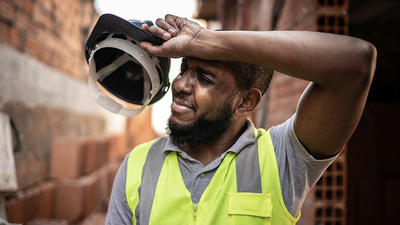Top ten plumbing problems and how to solve them

Whether it’s an emergency callout, planned maintenance, a brand-new installation or something in between, installers are faced with a variety of plumbing problems every single day. While some of these challenges are anticipated and straightforward to solve, others may hinder progress on projects and become a headache for installers.
Let’s take a look at ten of the most common plumbing problems – and the steps that installers can take to tackle them.
1) Leaking connections
Regardless of whether it is a soldered copper connection, or a connection between a plastic push-fit fitting and pipe, leaking connections are one of the most frequent plumbing problems that installers run into. Whether it’s a result of wear and tear over the years, or just a poorly made connection, leaks can be frustrating to deal with – as well as being costly for customers with the potential to cause damage to property.
To minimise the chances of leaks occurring in the future, there are some best practice tips which installers can follow. This starts at the point of installation, ensuring pipe ends and fittings are clean and free of debris or sharp ends to create the best connections. When working with plastic pipes and fittings, using pipe inserts, such as JG Speedfit’s Superseal pipe insert, keeps pipe ends perfectly rounded, minimising loss of shape during cutting and throughout their service life. Additionally, when these inserts are used alongside JG Speedfit Twist & Lock® fittings, a unique multi seal is formed between the inserts’ own dual O-rings and the O-ring of the fitting itself. Therefore, achieving additional leak protection, keeping customers happy and systems free of leaks far into the future.
2) Maintaining standards in tight spaces
As installers, sometimes it can feel like your entire day can be taken up making connection after connection, creating a maze of pipes and fittings. Similarly, confined spaces and hard-to-reach areas can make it difficult to make strong and reliable connections, even when making connections, using plastic push-fit fittings and plastic pipe which are tool and flame free. This is where using flexible pipe materials can be of benefit.
JG Layflat Pipe is a polybutylene pipe solution that can fit through joists and bend around corners. The flexibility of the pipe means that you can cut down on the number of connections that need to be made, as well as make those awkward connections more easily.
3) Deciding on what material to use and where
When mapping out a project, one of the first things an installer will have to figure out is what kind of pipework is best suited for the task in hand. While some will insist on using copper, in the majority of situations, plastic is a practical solution which can be easier to install and improve the performance and longevity of systems.
The only situations where copper absolutely must be used, is the first metre of pipework directly connected to a boiler, and in a circulatory hot water system. In all other situations, plastic pipework is just as well suited to the task at hand, if not more so.
4) Dealing with emergency callouts
Emergency repair and maintenance callouts are a crucial part of an installer’s everyday job – but they can certainly be classed as a plumbing problem when they happen at inconvenient times. In order to respond to every possible scenario, preparation is key.
Experience is obviously going to be paramount in situations like these. However, having the right tools to hand is as big a part of that as any other. For new apprentices through to highly experienced installers, products such as the JG Speedfit Appliance Tee, JG Speedfit Stop Ends, and JG Speedfit Layflat Pipe are must-haves in order to quickly and easily respond to common problems.

5) Having to fix other installers’ work
Water Regs UK recently conducted a survey that found that more than half of all installers spend a portion of every day fixing others’ poor work, be this from unqualified installers through to overly confident DIYers.
Of those asked, most installers said that incorrectly installed or low-quality fittings were one of the main culprits of this plumbing problem. With this in mind, when it comes to fixing problems caused by incorrectly installed fittings, the best solution is to have a selection of high-quality fittings such as JG Speedfit Twist & Lock® to hand, ensuring best installation practice is followed to ease maintenance-related work in the future.
6) Tackling jobs without isolation valves
A lack of isolation valves can mean that larger sections of a home’s water than necessary will need to be drained off for maintenance to take place, which wastes both water and time.
Unfortunately, there’s not an easy way to get around this other than making sure that all of your own first fix installations are made with future maintenance in mind. This means it won’t be an issue if a customer calls you back due to an issue or to conduct maintenance. When it comes to choosing which isolation valve to use, a good choice would be the JG Speedfit Ball Valve with push-fit connections, which allows the user to stop the flow of water to a fixture or zone in the event of an emergency or for repair work.

7) Keeping up with new regulations
In an effort to enhance the efficiency of homes, Part L of the Building Regulations have recently been updated, with changes coming into effect as of June 2023. While most of these changes will be familiar to most installers, it is important to stay up to date with best practice to make sure simple mistakes aren’t made on the job.
8) New boiler quotes
While the majority of the new regulations aren’t going to cause many plumbing problems for installers, there is one update that is going to change how we go about installing new boilers.
Paragraph 8.8 of the amended Part L document states that new boilers and emitters have to be commissioned and sized correctly, and that there needs to be evidence of this being the case, with all of the information provided to the customer under the new Standard Assessment Procedure.
All of this means that an installer now has to take on a lot more work in order to provide an estimate on a price to a customer. This essentially means that the days of offering free boiler quotes are in the past, unless you want to be doing extra work for free.
Customers may expect free quotes to still be the norm, but as an experienced installer you need to explain that in order to offer the right level of service, installers across the board now have to start charging. Furthermore, if a customer knowingly hires another installer that says they can do the job for free but without doing the right checks, the customer themselves can be fined.

9) The skills shortage
There are a number of contributing factors as to why the skills shortage continues to affect our industry, be it a lack of uptake of trades amongst the younger generation, the effects of social trends and politics, or even more experienced installers choosing to retire.
Whilst installers themselves can’t be expected to rectify this situation, we should always strive to encourage apprenticeships and education at all stages of development. Whether that be engaging with young people in the local community or taking on an apprentice where possible.
Similarly, regardless of your level of development, installers at all stages should always be striving to learn new things, which brings us onto…
10) Keeping your skills up to date
In today's rapidly evolving industry, staying up to date with the latest legislation and technological advancements is essential for installers at all stages. However, the speed of this change has increased to such a pace, that it can become a major challenge for installers to keep up, leaving them lacking skills crucial to their work.
In recognition of this and to support installers overall, we offer expert advice across all of our blog updates and our technical support team is always on hand to help with any enquiries you may have.
We hope that you found these ten suggestions helpful.
Discover more
To learn more about RWC and their family of brands please click below.
